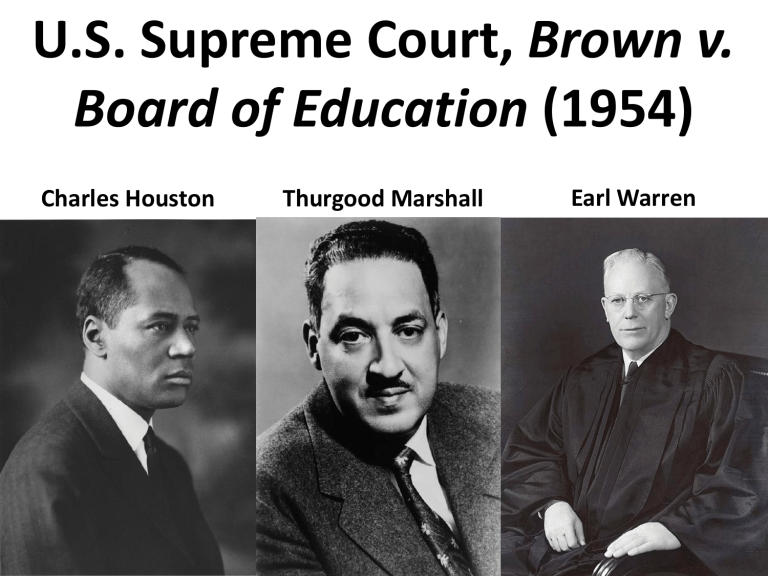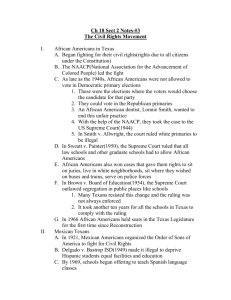U.S. Supreme Court, Brown v. Board of Education
advertisement

U.S. Supreme Court, Brown v.
Board of Education (1954)
Charles Houston
Thurgood Marshall
Earl Warren
Background
Charles Houston
• Attended Amherst College and Harvard Law
School.
• He became the first African‐American member
of the Harvard Law Review in 1921.
• Joined the law faculty at Howard University in
1924, where he was academic dean from 1929
to 1935.
• Was head of the NAACP’s Legal Defense Fund
from 1933 until his death in 1950.
Background: Thurgood Marshall
• Born July 2, 1908 in Baltimore, MD.
• Received his B.A. degree from Lincoln University
in 1930.
• Studied under Charles Houston and graduated
first in his class from Howard Law School in
1933.
• He was enlisted to help with the civil rights battles being
waged by the NAACP after graduation.
• Took over the Legal Defense Fund, after Houston’s death in
1950.
• Argued the Brown v. BOE case for the first time in 1952.
• A divided court asked to have the case reargued in October
1953.
• On May 17, 1954, the court unanimously ruled in favor of
Brown.
Chief Justice Fred Vinson
President Dwight Eisenhower
Chief Justice Earl Warren
Background: Chief Justice Earl Warren
• Republican attorney, who served as governor of California from 1943-1953.
• Warren lost the presidential nomination in 1952 to Eisenhower.
• President Eisenhower nominated Warren for the Supreme Court and was sworn in
as Chief Justice on October 5, 1953.
• Eisenhower later regretted his choice. He had hoped to appoint a moderate
conservative, but Warren proved to be an unabashed liberal.
Historical Background
• Linda Brown was a young black girl that was a student in a
segregated school. She had to cross railroad tracks and ride
a school bus twenty-one blocks to a black school, even
though there was a white school only five blocks away. The
attorneys forced the court to answer why African
Americans were singled out for different treatment. The
attorneys also made the point that racial segregation
deprives students of important interaction with others that
enhances learning on May 17, 1954. The courts ruled in
favor of desegregation on the grounds that separate
educational facilities are inherently unequal since they
deprive minority student’s equal educational opportunities
essential to their success in life.
THE ISSUE OF SEGREGATION OF PUBLIC EDUCATION FOCUSED ON THE
AFRICAN AMERICAN COMMUNITY.
THE INTEGRATION OF PUBLIC SCHOOLS MET STRONG WHITE OPPOSITION.
“Americans had always believed that the public schools were agents for social
advancement, and the possibility of integration conjured up white persons’
fears of interracial marriages, moral decay, and collapsing academic standards.
Besides, for most white Texans, segregated public institutions validated the
presumed inferiority of black persons.” (p. 370)
Calvert, De León, Cantrell, p. 370.
SWEATT v. PAINTER: Thurgood Marshall of the NAACP argued that lawsuits
forcing black enrollment in professional and graduate schools would least
antagonize whites. The NAACP decided to sue the University of Texas for the
admission of a black student to its school of law on the grounds that no school
in Texas offered black people a law education. Heman Marion Sweatt, a
Houston post office employee, agreed to become the plaintiff and seek
admittance to U.T.’s law school. The conservative leadership in the state
attempted to thwart the suit by broadening educational programs at Prairie
View State Norman and Industrial College and changing the name of that
institution to Prairie View University, incorporating Texas Southern University
into the state system, and establishing an all-black law school in the basement
of the state capitol.
Calvert, De León, Cantrell, pp. 370-371.
In response, NAACP attorneys
changed their strategy to one
that argued that the University
of Texas’s excellent reputation
in law meant that any rival
segregated institution
necessarily offered an inferior
degree. The Supreme Court
agreed in the 1950 Sweatt v.
Painter decision and ordered
the integration of U.T.’s law
school.
Thurgood Marshall with
James Nabrit Jr. and George
E.C. Hayes after their victory
in the Brown v. Board of
Education case before the
Supreme Court, May 17,
1954.
The Fiftieth Legislature established
Texas Southern University and
expanded graduate education at Prairie
View A&M in an attempt to thwart
Heman Sweatt's application to enter
the University of Texas.
In Brown v. Topeka Board of Education (1954), the
Supreme Court ruled that segregated schools were
inherently unequal and thus unconstitutional.
A public opinion poll reported in 1955 that white Texans
opposed integration by four to one, whereas black
Texans supported desegregation by two to one.
Court Decision: “We conclude that, in the field of public
education, the doctrine of ‘separate but equal’ has no
place. Separate educational facilities are inherently
unequal.”
Calvert, De León, Cantrell, p. 372.
Linda Brown and her new class mates after the Supreme
Court’s decision in Brown v. Board of Education.
NAACP lawyers congratulate each
other on the decision in Brown v.
Board of Education of Topeka
(1954). Attorney Thurgood
Marshall, center, was later named
the first African American justice
of the Supreme Court.
Case Background
• The case of Brown v. Board of Education of
Topeka, Kansas combined four cases challenging
racial segregation in public schools. In addition to
Topeka, districts in Delaware, South Carolina, and
Virginia participated in the lawsuit.
• In Brown v. Board, 13 parents of 20 students filed
suit in the U.S District Court of Kansas to
challenge the 1896 ruling of Plessy v. Ferguson,
which made racial segregation legal through its
"separate but equal" clause.
Case Background Cont.
• A Kansas statute allowed cities with populations of
over 15,000 to provide separate schools for AfricanAmerican and white students. These 13 parents were
urged by the NAACP to enroll their children in
neighborhood schools, rather than allow them to be
bussed to one of the four African-American schools.
Each of the students was denied enrollment.
• When heard in the U.S District Court, the court
concurred that segregation was harmful to the AfricanAmerican students. However, the ruling itself favored
the school board, and enrollment for these students
was denied.
Main Points
• Separate is inherently unequal.
“The plaintiffs contend that segregated public
schools are not “equal” and cannot be made
“equal,” and that hence they are deprived of the
equal protection of the laws…”
“We conclude that in the field of public education
the doctrine of “separate but equal” has no place.
Separate educational facilities are inherently
unequal.”
Main Points Cont.
• Education is a right, not a privilege.
"In these days, it is doubtful that any child
may reasonably be expected to succeed in life
if he (or she) is denied the opportunity of an
education. Such an opportunity, where the
state has undertaken to provide it, is a right
which must be made available to all on equal
terms."
Main Points Cont.
• Segregation is a violation of the Fourteenth Amendment
because it denied people equal protection of the law.
“In approaching this problem, we cannot turn the clock back
to 1868 when the Amendment was adopted, or even to
1896 when Plessy v. Ferguson was written.”
“Therefore, we hold that the plaintiffs and others similarly
situated for whom the actions have been brought are, by
reason of the segregation complained of, deprived of the
equal protection of the laws guaranteed by the Fourteenth
Amendment.”
“This disposition makes unnecessary any discussion
whether such segregation also violates the Due Process
Clause of the Fourteenth Amendment…”
After the Courts Ruling
• Massive resistance followed the decision. Rather than desegregate
as ordered by the U. S. Supreme Court, some state governments
defied the Court
• National Guard troops were called out to escort African American
students into formerly all white schools.
• Freedom of Choice schemes were used to circumvent
desegregation. New York Times reporter Adam Cohen in his
January 18 article "The Supreme Struggle" said "Southern states
adopted legal tactics to stall integration, notably "freedom of
choice" plans. In theory, freedom of choice allowed blacks to
attend any school in a district, but black parents were threatened
with losing their jobs and homes – and having crosses burned on
their property – if they tried to send their children to white
schools."
Governor Allan Shivers Opposed Desegregation: “Governor Shivers was a staunch advocate of
states rights, and believed that Texas should resist any federal attempts to integrate the public
schools. Many white Texans agreed with him, and his mailbag was flooded with letters, many of
them unprintable, opposing integration. In 1956, the Mansfield school district near Fort Worth
was the first in Texas to be ordered to desegregate. An angry mob prevented three black
students from entering the high school. Shivers ordered the Texas Rangers to the town to
protect the mob and prevent the students from attending school. The Eisenhower
administration, in the middle of a reelection campaign, did not intervene. Shivers' example
inspired Arkansas Governor Orval Faubus the next year in his resistance to the desegregation of
Central High in Little Rock. In that case, the federal government sent in the Army and enforced
the law of the land. In the years that followed, many Texas school districts willingly
desegregated, but others held out until 1965, when the federal government threatened to
withdraw funds.”
DOCUMENT: Levelland constituent V. McMurry
urges the governor to continue his fight to
maintain segregated schools and to keep the
tidelands in state control.
SOURCE: V. McMurry to Shivers, January 10, 1955,
Records of Allan Shivers, Texas Office of the Governor,
Archives and Information Services Division, Texas
State Library and Archives Commission.
http://www.tsl.state.tx.us/governors/modern/shiversmcmurry.html
Desegregating University of North Texas
In December 1955, U.S. District Judge Joe Sheehy issued an injunction prohibiting North Texas from denying admission on
the basis of race. Atkins already had enrolled at Texas Western in El Paso, but the door he opened led to the arrival of North
Texas' first African American undergraduates and master's students in 1956.
Irma E.L. Sephas began classes with little notice in February 1956, the same day a screaming, rock-throwing mob threatened
Autherine Lucy as she entered the University of Alabama. After three days of violent rioting, the university expelled Lucy,
saying it was for her own safety.
Determined to prevent similar scenes in Denton, Matthews ordered a virtual news blackout and kept television cameras out
of classrooms. He even refused to brag about North Texas' peaceful desegregation.
"President Matthews' primary concern was that to point to the fact that nobody was
throwing rocks at Sephas was to invite somebody to come and throw rocks at her,"
said James Rogers in a 1980 oral history interview. Rogers, now a Professor Emeritus
of journalism, was university news director when Sephas arrived.
Yet, there were ugly incidents, Matthews said. Racial epithets were chalked on
sidewalks, but crews were out before classes began to scrub them off. Crosses were
burned in front of the administration building and at Matthews' home, but they
were extinguished without publicity.
The freshman class: That summer saw several more African American students at
North Texas, and in Fall 1956, the first group of freshmen enrolled. Among them
were two young athletes, Leon King ('62. '72 M.S.) and Abner Haynes ('62), who
integrated the North Texas freshman football team 10 years before an African
American played in the Southwest Conference.
Source: The North Texan Online
http://www.unt.edu/northtexan/archives/s04/history.htm
Above: North Texas students Bettye
Morgan ('60), second from left, and
from right, Burlyce Sherrill Logan,
Floydell Barton Hall ('60) and
Barbara Beverly Kincaide ('57) pose
with friends on campus in 1956.






